Results 11 to 20 of 31
Thread: A few questions about razors
-
01-06-2020, 03:28 AM #11


ELLIOT, JOSEPH
Sheffield
Trademark: C reversed and C, with a cross between
1821-1854 ("More Old Razors" by Lummus. Antiques, May 1927 p.372-374)
JOSEPH ELLIOTT (ELIOT) & SONS
Hollis Croft, Sheffield
ca. 1795 to present
WM. ELLIOT & CO.
New York City.
ca. 1880-1907; in 1907, the firm was taken over by Adolph Strauss & Co., who continued using "Wm. Elliot & Co." as a trademark.
Take two aspirins and write us in the morning.
 Our house is as Neil left it- an Aladdins cave of 'stuff'.
Our house is as Neil left it- an Aladdins cave of 'stuff'.
Kim X
-
01-06-2020, 03:34 AM #12Senior Member

- Join Date
- Feb 2019
- Posts
- 102
Thanked: 7
-
01-06-2020, 03:44 AM #13
-
01-08-2020, 03:46 PM #14Senior Member

- Join Date
- Feb 2019
- Posts
- 102
Thanked: 7
Found a stamp similar to mine, but with the word "eng". Probably, in fact, my late 1800s razor.
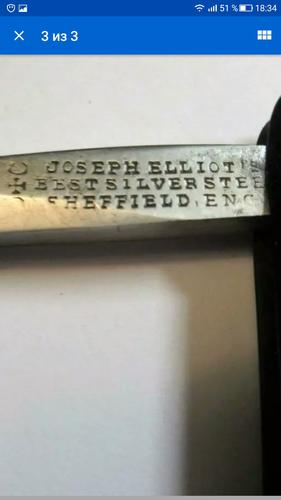
And my stamp doesn't even have the word "Sheffield"on it.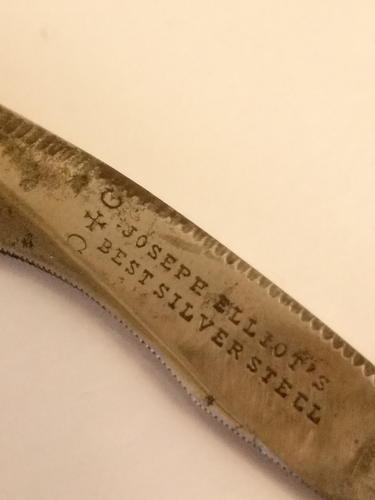
And here's another stamp. This razor is also dated to the end of 1800 s. The stamp is the Same.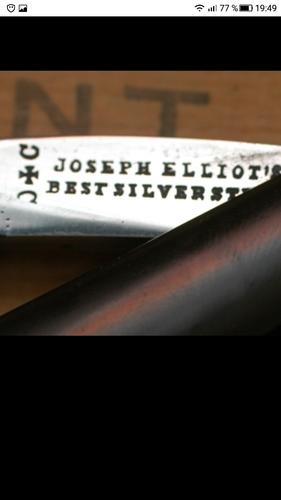
But the tail on my razor doesn't look like anything. Thick, massive.Last edited by esveka; 01-08-2020 at 05:03 PM.
-
01-11-2020, 02:39 AM #15

First and foremost, references like Uniclectica and Goins are sadly very, very badly out of date and filled with inaccuracies, and the tail-style chart is also a poor indicator. In practice, there were not a clean progression of styles.
The topic of razor manufacturers in the 19th century is vast, so generalized resources like those are at best pointing in a general direction.
Joseph Elliot is an especially tricky one to pin down.
Henry Lummus was basing his dates on extant directory listings, but in fact the company had been producing cutlery for two decades before their first listing. In fact the C(Maltese cross)C trademark was granted in 1805.
Stylistically, things are challenging because Joseph Elliot's wares were not made in a single factory, but at workbenches and wheels scattered through the facilities of several other manufacturers. On top of that, any given razor was only made for the name on the stamp, not necessarily by their workmen.
All that said, some of the stylistic elements of your razor point to a general timeframe of 1860's to 1890's: The filecut pseudo-jimps along the top of the tang, the machine-made stamp rather than hand-struck mark.
In other manufacturers, a phrase like 'Best Silver Steel' could be useful, as that was a fad that died out around the general time of the Bessemer steel process, but the Elliots apparently loved it and never stopped.
I wish I could give you a better, more objective measure of the date.
The scales are plausibly original.
As for the other razor -- that's an entirely new one on me! I assume it has no marks on the reverse side of the tang?-Zak Jarvis. Writer. Artist. Bon vivant.
-
-
01-11-2020, 07:58 AM #16Senior Member

- Join Date
- Feb 2019
- Posts
- 102
Thanked: 7
I want to Express my respect for your deep knowledge on this issue! I looked at probably hundreds of photos, read a few topics on the forums, but I have to admit that it didn't help much.
Tell me, can't there be some clue to the question of determining the age of razors the absence or presence of the word "Sheffield"? Still, on older razors, the "Sheffield" stamp is not common.
As for the other razor, there is nothing on the reverse side. But it is very similar to Sheffield and and scales from a bone without obvious traces of replacement.Last edited by esveka; 01-11-2020 at 10:45 AM.
-
The Following User Says Thank You to esveka For This Useful Post:
Voidmonster (01-14-2020)
-
01-14-2020, 12:48 AM #17

Alas, the presence or absence of 'Sheffield' is not helpful. I think the earliest razors I've seen that used it were late 1820's, and then it was used inconsistently ever since. Rather than a legally mandated mark (like the much later country-of-origin stamps), it was simply to reflect pride in the place it was made and to capitalize on Sheffield's reputation for excellent cutlery. In short, a marketing slogan not hugely different than Silver Steel or Universally Approved.
The Cut A Way razor, I agree, definitely looks like a Sheffield razor -- especially that cartouche around the name.
I poked around a little outside the usual sources (trade directories, Tweedale's directory, etc), and found another one sold in an auction.
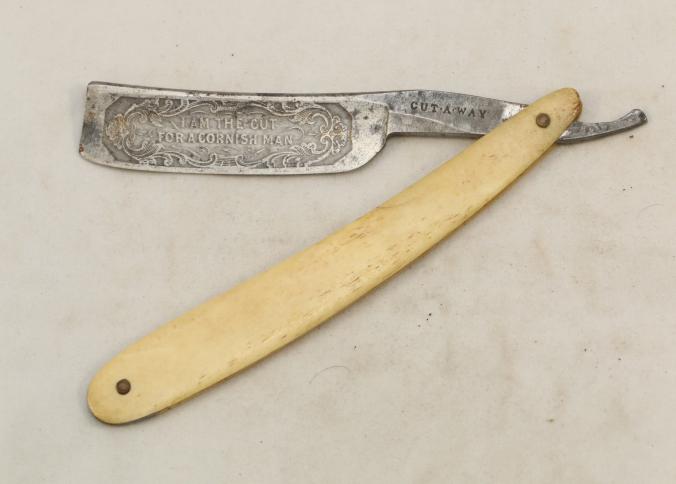
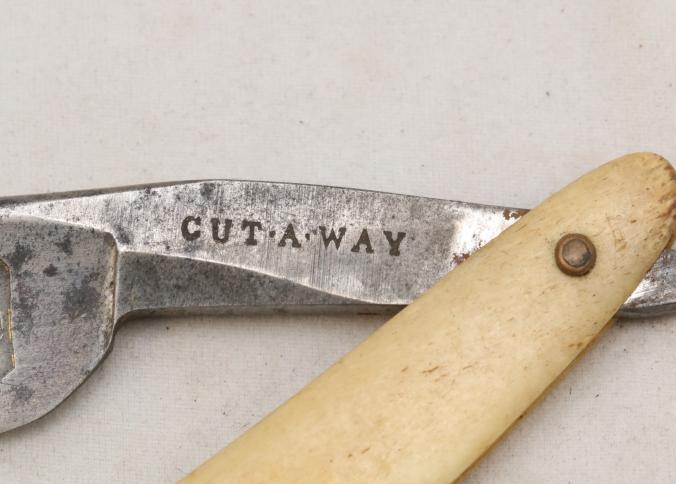
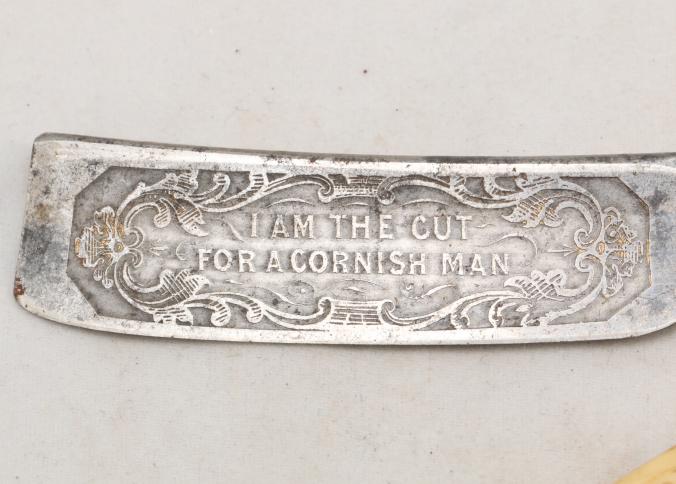
Pretty clearly the same maker, but again with no clues as to who it actually was. It does at least contribute the data point that they are likely to have been in Cornwall (though the blade could still easily have been manufactured in Sheffield).
I'd say that's a rare, and quite interesting one! I'll keep doing what I can to find the manufacturer, but currently I don't have quite enough to go by (there were a lot of cutlers in Cornwall).-Zak Jarvis. Writer. Artist. Bon vivant.
-
The Following User Says Thank You to Voidmonster For This Useful Post:
esveka (01-14-2020)
-
01-14-2020, 12:37 PM #18Senior Member

- Join Date
- Feb 2019
- Posts
- 102
Thanked: 7
Thank you very much! What you did - is incredible! I didn't think it was possible to get any information about this razor.
Cartoushe I saw on very old Sheffield razors. Although, like the absence of the word "Sheffield", the presence of a cartouche can hardly be an indication of a very old age.
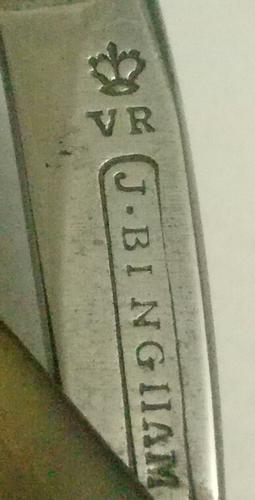 I only have one razor with a cartouche.
I only have one razor with a cartouche.
-
01-14-2020, 07:39 PM #19Senior Member

- Join Date
- Feb 2019
- Posts
- 102
Thanked: 7
It's probably a coincidence, but... Note the shape of the frame around the etching and the shape of the cartouche


Last edited by esveka; 01-14-2020 at 07:41 PM.
-
01-14-2020, 08:15 PM #20

I did not find much, but like Zak, saw this in Robert Doyle's auction.
Reputed to have come from Lummus' pile?
If anyone could have found-out, it would have been them. (with exception of the late Neil Miller, of course!)
"Straight Razor. Cut-A-Way. C-1850-70. The wedge blade is fully etched with scroll surrounding “I AM THE CUT FOR A CORNISH MAN.” (The Cornish people or Cornish (Cornish: Kernowyon) are an ethnic group native to, or associated with Cornwall and a recognised national minority in the United Kingdom, which can trace its roots to the ancient Britons who inhabited southern and central Great Britain before the Roman conquest.) I have never seen this etching on another razor. The Whalebone handle is decorated with the red dot code of Henry Lummus and bears his inventory number “1005.” Henry T. Lummus Collection assembled before 1920. Lummus wrote articles on straight Razor Collecting for "Antiques" magazine in the 1920's. The red dot pattern was some type of code that Henry applied to many of his straight razors. Although I bought his 500 piece collection from his Estate over 40 years ago, and tried to review all the designs to try and find what they had in common, I could not break the code."
-


 51Likes
51Likes LinkBack URL
LinkBack URL About LinkBacks
About LinkBacks








 Reply With Quote
Reply With Quote

